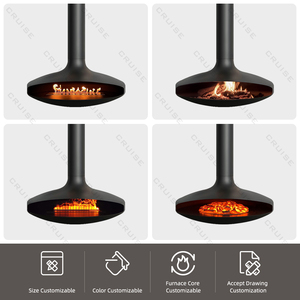Introduction to Fireplace Flue Pipes
Fireplace flue pipes are essential components of a chimney system, allowing smoke to safely exit your home while ensuring optimal airflow for your fireplace. These pipes not only enhance the efficiency of your heating system but also play a crucial role in maintaining indoor air quality. Made from durable materials, fireplace flue pipes are designed to withstand high temperatures and resist corrosion, making them a vital part of any fireplace installation. Whether you're renovating your space or building a new fireplace, understanding the types and features of these pipes can help you make an informed choice.
Types of Fireplace Flue Pipes
When it comes to fireplace flue pipes, there are several types available, each designed to cater to specific needs and setups:
- Single-Wall Flue Pipes: These are commonly used in residential settings and offer excellent heat resistance. They are typically made of stainless steel or galvanized steel.
- Double-Wall Flue Pipes: Featuring an insulated design, these pipes provide better heat retention and minimize the risk of burns and fires. They are ideal for areas where the flue pipe runs close to combustible materials.
- Class A Chimney Pipes: These are high-temperature pipes that are pre-fabricated with insulation, making them suitable for venting wood or gas fireplaces through the roof.
- Flexible Flue Pipes: Perfect for complex installations, these pipes can easily fit through tight spaces and are often used in retrofits of older systems.
Function and Features of Fireplace Flue Pipes
Fireplace flue pipes come with a range of functions and features that enhance their performance:
- Smoke Ventilation: The primary function of flue pipes is to facilitate the safe venting of smoke and gases out of your home, reducing the risk of smoke inhalation and maintaining air quality.
- Insulation: Many flue pipes are designed with inner insulation to keep the exterior cool to the touch, which protects surrounding materials from heat exposure.
- Corrosion Resistance: High-quality fireplace flue pipes are often coated or manufactured from materials that resist corrosion, ensuring longevity and reliability.
- Modular Designs: Some flue pipe systems offer modular components, allowing for customizable installations that can adapt to various chimney heights and configurations.
Applications of Fireplace Flue Pipes
Fireplace flue pipes are utilized in various applications, enhancing both functionality and safety in distinct settings:
- Residential Fireplaces: These pipes are commonly installed in homes to maintain efficient fireplace operation and safe gas venting.
- Wood-Burning Stoves: Flue pipes are essential for wood-burning stoves to channel smoke effectively and ensure proper combustion.
- Outdoor Fireplaces: Many homeowners incorporate these pipes into outdoor structures to control smoke flow and improve the experience of outdoor heating.
- Commercial Installations: Restaurants and commercial kitchens also rely on specialized flue systems to handle the venting of smoke and exhaust safely.













































